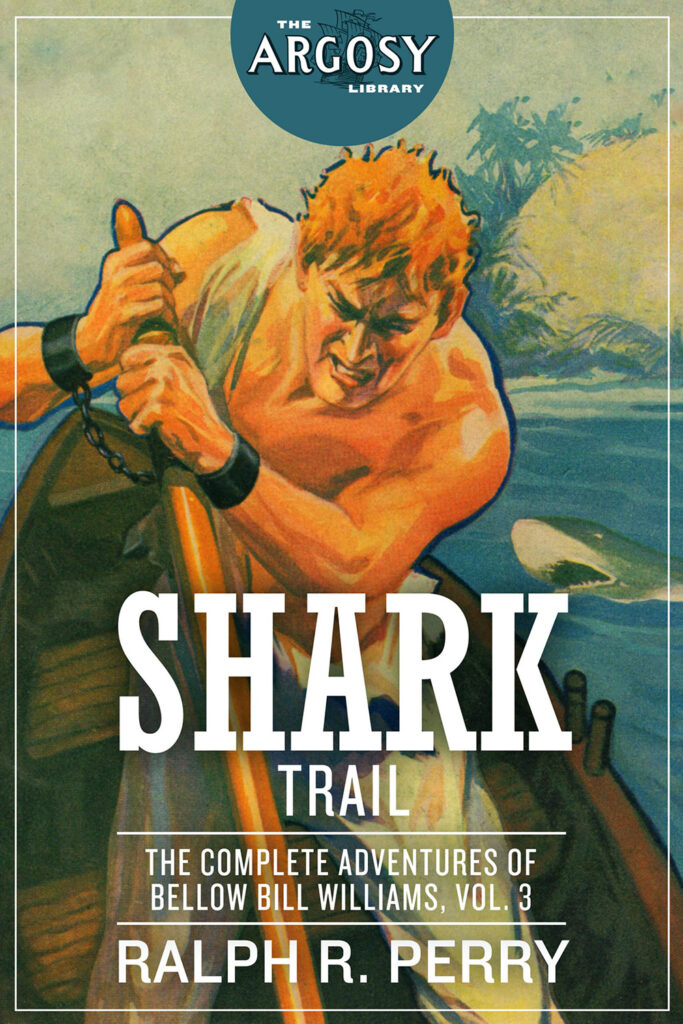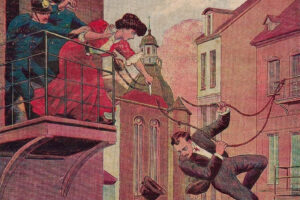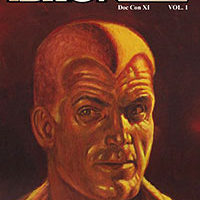“Bellow Bill” Williams is a South Sea island pearler who has various adventures. Never before reprinted, Shark Trail: The Complete Adventures of Bellow Bill Williams, Vol. 3 is the third and final volume with the last eight stories from Argosy.
 I had gotten the first volume from Steeger Books when I heard it touted that Lester Dent read the series and it influenced his Doc Savage stories. I enjoyed the first two and looked forward to this one as well.
I had gotten the first volume from Steeger Books when I heard it touted that Lester Dent read the series and it influenced his Doc Savage stories. I enjoyed the first two and looked forward to this one as well.
Ralph Perry (1895-?) wrote adventure stories, many with a nautical theme, but also some westerns. But his works stopped after 1941. Did he get involved in WWII and pass away? I have no idea.
“Bellow Bill” Williams seems to be his only serial character. He appeared from 1929 to 1936, and this volume covers June 1934 to March 1936.
Bellow Bill is a big man, six-foot-three and 225 pounds. His hair is curly and coppery gold in color, and he has dark blue eyes. And he has tattoos. His arms are covered with them. Ropes are tattooed on his wrists, with stars, butterflies, and serpents running up his arms. A dragon is on his chest, a full-rigged ship on his back, and a snake around his waist finishes that off. He chews tobacco. And his nickname is due to his bellowing voice. While Bill is a big and strong character, he is not dumb and works out plans for his actions. And he has a core of ethics, doing the right thing. Several times he passes up a fortune for the right reasons.
There are no regular secondary characters in these stories, nor are they set around a particular island or location. This allows Bill to rove the South Pacific, meet difference characters good and bad. Now, how the Chinese and natives are treated might be off-putting to some, but you need to read these for the adventure and danger. Keep this in mind. The good people treat everyone decently, the bad people don’t.
In this volume, we get the following stories:
In “The Scar” (Argosy, June 2, 1934), Bill comes across a yacht that is burning, but has no survivors. When he sees a body missing a head, he wonders if some of the natives have gone back to headhunting. Then he finds a young girl floating in the water, the only survivor. She tells of them taking on a group of natives, who suddenly attack and kill everyone. They are lead by a white man who is made up as a native, even having a ritualistic scar on his chest. Bill figures that some white man in the area has formed a new group and thinks he knows who it is and sets out to trick the man in revealing himself. Will Bill succeed, or will his target get the best of him?
With “The Jungle Master” (Argosy, July 14, 1934), Bill steps in to help an old man and his daughter. Bill had dropped off supplies for them as the two are partners with another man in a gold operation in Borneo. But on the beach, they are attacked by natives, and the old man is hurt. What about his partner back in the jungle? Was he attacked as well or was the attack something he planned to eliminate his partner and take all the gold for himself? Bill aims to find out despite the danger. What will he find?
Bill gets blood poisoning and needs to see a doctor soon or lose his arm. So he heads to a nearby island in “Blood Payment” (Argosy, Oct. 6, 1934) where he knows a former ship’s doctor is running a coconut plantation with another. But when he gets there, strange goings on greet him. The natives are acting up. The doctor’s partner has drowned, and the doctor tries to calm things down, but disappears. A young woman is at their place. Can Bill get to the bottom of things, and more importantly get his arm taken care of?
The next story, “The Rats of Mahia” (Argosy, Dec. 1, 1934), starts off with a bang. On a French colony during a hurricane, a party is being held at the consul general’s residence. Suddenly a native breaks in, murders Lady Baily-Nickerson and takes her sapphire necklace and escapes. He makes a run for it. But when Bellow Bill follows, he jumps into the bay but gets away as there was a dugout waiting for him. Bill says with the storm leaving, there is only one place he can head for: an abandoned plantation on Mahia. Clearly whoever hired him is there. Bill finds the boat of Knife-hand Foster and heads inland to find him, along with the necklace, and bring him to justice. What will Bill face?
“Fangs of the Fetish” (Argosy, Feb. 23, 1935) also gets us right into the action. After selling his cargo of pearl shell, Bill helps stop an ambush by a group of Papuans on a man, who is able to get the drop on them. The man, Namu Pierce, has recently been released from prison for manslaughter and he believes he knows who the men who attacked him work for. They all work on the plantation of his former partner, Wallaby Marsden. But why did they attack? Pierce says they used to be partners, but each hoped to outfox the other to get the whole amount they had amassed. Marsden succeeded, destroying the partnership paper held by Pierce and framing him for murder. But Pierce had hide the actual paper in a fetish he gave to a native. And he wants Bill to help him get it. But when they do, Bill finds that the paper is instead a marriage certificate. What is going on? And how is Marsden’s kid mixed in it?
The quest for a sunken Spanish galleon is at the center of “The Golden Oyster” (Argosy, May 25, 1935). Bill is asked by a local English resident to come in secret, and take a college professor, his daughter and her fiance to a remote atol to get the gold. But the word has somehow gotten out, as Bill is waylaid by a man with a similar build who is in league with the local Dutch trader to that island. Can Bill and his passenger safely get the gold or not?
A derelict sailing ship is found by Bill in “The Atoll of Flaming Men” (Argosy, Oct. 19, 1935). On board are several dead bodies, but what killed them? Bill hauls the ship to the nearest port, but decides to set it free to run ashore and see what happens. When it is instead set afire, Bill knows that this port is at the center of what is going on and he’ll put an end to it.
Finally, in our title story, “Shark Trail” (Argosy, March 21, 1936), Bill is asked to check things out in Port Cooke. For several years, there have been several strange disappearances. Always when a pearler arrives with a good haul of pearls, they seem to strangely wander into the local bog, never to be found. Is there someone behind this? Someone known as “The Shark”? Can Bill get to the bottom of things, literality, without also disappearing in the bog?
So having read the whole series, what do I think of the claim that he influenced Doc Savage? Well, Bill is not Doc. While he has the size of Doc, and his ethical behavior, that’s about it. Personality-wise, Bill is different. He is loud, with a personality to match. He is called “Bellow Bill” for a reason.
Bill is an expert sailor, and certainly can shoot and fight, and knows some of the local languages, but has no other unusual skills. He will get involved for the right reasons, figuring out what is going on, and solving the mystery involved. I found it interesting that in a couple of these stories, he lets us know why he lives this life.
Overall, these are enjoyable stories of South Seas adventures. I don’t know if I would have bothered to read them had there not been a Doc Savage connection. The stories, as I said, are adventure tales with some mystery involved, in terms of trying to understand what is behind everything. That’s great, but I prefer stories with more fantastical elements, which isn’t here. But these are great examples of South Seas pulps stories.



